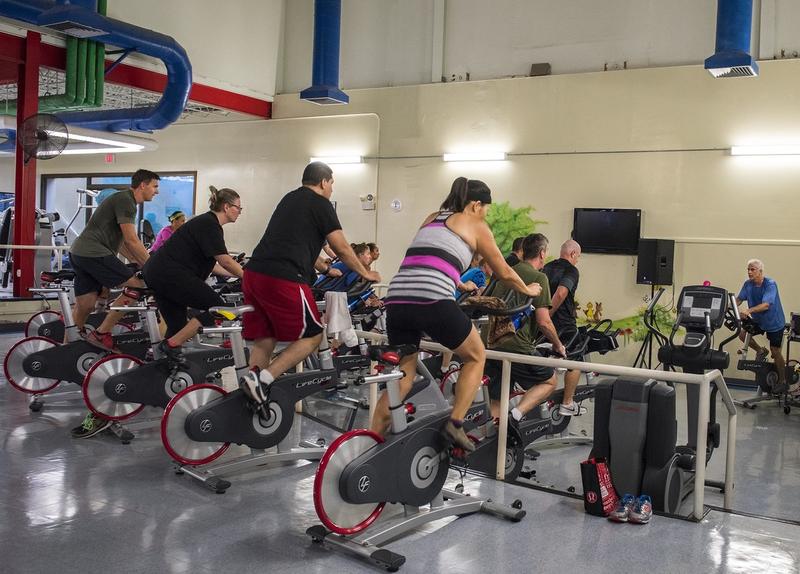In today’s world of fitness, technology and group exercise are commonly part of a person’s workout routine, and a University of New Mexico educator says we have come a long way since the beginning of exercise.
Dr. Len Kravitz, professor of exercise science and coordinator of exercise science at University of New Mexico, spoke with “Take Care” about the history and current state of exercise. His latest book is “HIIT Your Limit: High-Intensity Interval Training for Fat Loss, Cardio and Full Body Health.”
Before the arrival of fitness as its practiced today, the concept of exercise was more sport and competition based, Kravitz said. The fitness component came with lifting objects like rocks to develop muscularity, which later developed into the sport of body building.
The popularity of fitness had a surge in the 1970s when Dr. Kenneth H. Cooper ignited the modern fitness revolution with his international best-selling book “Aerobics,” Kravitz said. Cooper presented research showing how beneficial aerobics was.
A second big surge was in 1980s, with Jane Fonda’s exercise videos sparking an interest in group exercise and exercise fashion, he said. Nowadays, the exercise is still done in groups, and popular exercises shift depending on the type of exercise involved, Kravitz said.
“When you say the most popular form of exercise, you’re without a doubt getting two mainstream peaks. And that’s anything that is bodyweight or resistance training and then anything that is aerobic, and most of them have pretty big categories,” Kravitz said.
Group exercise has never faded and probably will never fade due to the social nature of humans, Kravitz said.
“We have just surged in our technological aspects of any kind of exercise. … We really understand what’s best for the body.”
“There’s a social phenomenon when you’re in a class with other people,” he said. “I’m not the best one to predict it, but we will see in 30 years, group [exercise] will be with us, but it will be another form, it will be another name, and it there will be a strong following with it.”
As far as the best form of exercise, Kravitz said there is a lot of promising research being done showing the health benefits of high-intensity interval training (HIIT) workouts, where there are spurts of high-intensity actions alternated with lower-intensity behaviors.
“The research is so wonderful … it’s wonderful for health, cardiovascular disease prevention and for fat loss,” Kravitz said. “The reason that type of training is so popular now is you can do it in almost 50% less time than the traditional steady-state type of exercise. And time, now, seems to be critical for everyone.”
CrossFit and other HIIT workouts have grown in popularity, Kravitz said, but they are not for everyone.
“There is a big part of our population that really loves the challenge, but what I really try to endorse is you challenge yourself at your own level,” Kravitz said.
Kravitz said it is important to remember that the health and wellness industry is a system looking to make a profit, so that means people have to keep in mind cost. Thankfully, he said, the prevalence of fitness programs has made many inexpensive programs accessible to those who could benefit from them.
The biggest force of change for exercise has been technology, especially in recent times when wearables and apps allow the tracking of many sources of data for a full-picture view of fitness.
“The growth of the exercise industry was when these innovators – product developers – started working with scientists alongside them with their research and product development taking us to a whole new level of evidence-based type of exercise products,” Kravitz said. “We have just surged in our technological aspects of any kind of exercise. … We really understand what’s best for the body.”
That growth in technology has changed the way we exercise, Kravitz said, with an emphasis on data that can motivate some to exercise more.
“It’s all about awareness,” Kravitz said. “People love ways of tracking what they’re doing. … If you are moving more, you’re affixed to your wearable technology, it is all about one thing: you are improving your quality of life and hopefully the quantity of years of quality of life.”
Technology is only going to get more sophisticated, Kravitz said, making it possible to one day have wearables and apps provide accurate exercise prescriptions without the need for a personal trainer.
“The technology is going to be so proficient that it’s going to be able to monitor several different body signs and say ‘this is a perfect starting point for you,’”Kravitz said. “I see that being the next evolution.”
Technology and other advances in exercise can lead some to believe that there are more people exercising, but in fact, Kravitz said, it is simply some people exercising more. He said that the fitness industry is generally good at getting people started on exercise programs, but at least 50% drop out in six months. Only 10% of the American population is keeping modern fitness programs alive, he said.
“We still have this incredible challenge,” Kravitz said.













